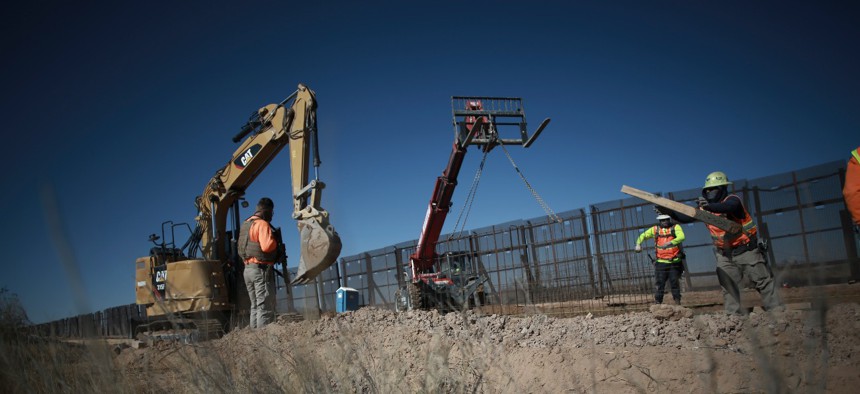
Workers prepare the foundation for a steel section of border wall that will be built on the Mexican side of older metal fencing dividing Ciudad Juarez, Mexico, from Sunland Park, New Mexico, on Jan. 12. Christian Chavez / AP
Biden Pauses Construction on the Border Wall
The president also ordered a review of all funding and contracts.
President Biden paused construction of the U.S.-Mexico border wall and ordered a review of its contracts and funding, hours after being sworn in on Wednesday.
The border wall was a signature of President Trump who made strict immigration policies a cornerstone of his administration. However, many viewed the wall as a waste of taxpayer resources and symbolism for xenophobia. Biden’s executive order on the border wall was one of the first he signed on Wednesday evening and one of several aimed at reversing the Trump administration’s immigration agenda.
“Like every nation, the United States has a right and a duty to secure its borders and protect its people against threats. But building a massive wall that spans the entire southern border is not a serious policy solution,” said the proclamation. “It is a waste of money that diverts attention from genuine threats to our homeland security. My administration is committed to ensuring that the United States has a comprehensive and humane immigration system that operates consistently with our nation’s values.”
The directive terminated the national emergency for the Southern border that Trump issued on February 15, 2019, shortly after the end of the longest shutdown in history, which resulted from differences over funding for the wall.
It says the Defense and Homeland Security secretaries along with the Office of Management and Budget director must direct the appropriate officials to pause construction on the wall (in no more than a week); assess the legality around the funding and contracting methods for the wall and consequences for canceling the agreements; pause obligation of funding to the wall; and compile a report on all border contracts, funds and the status of each project. The proclamation notes that the pauses must be “to the extent permitted by law.”
It also directs the Defense and Homeland Security secretaries, in consultation with the Treasury secretary, attorney general and OMB director to create a “plan for redirecting funding and repurposing contracts” within 60 days of the order. Biden named interim appointments on Wednesday to serve until his nominees are confirmed.
According to an estimate from the Army Corps of Engineers, upon which The Washington Post reported last month, Biden could save $2.6 billion by halting construction on the wall; however, “the financial implications of a decision to stop work — including the costs to the government it will potentially incur — have not been publicly disclosed.”
The Trump administration came under scrutiny for costing for taxpayers much more than anticipated for the wall, waiving regulations to speed up construction, allegedly improperly influencing a $400 million contract, attempting to divert funds from the military to the wall and not ceasing construction during the coronavirus pandemic. On January 5, Chad Wolf, then acting DHS secretary, said the Trump administration completed the 450th new mile of the wall.
There has been much debate over whether or not the construction has been on a new wall and if it is actually a wall or just replacement fencing. “Using these extremes often does not capture the complexity of the situation in terms of what [Customs and Border Protection] states the barriers can be expected to do and the realities of the terrain and geography of the border,” said The Congressional Research Service in a report last year.
“Much of the current wave of construction—whether new or replacement barriers—is 18- to 30-foot high reinforced bollard fencing. It poses a formidable barrier, but it is not the high, thick masonry structure that most dictionaries term a ‘wall,’ ” said the report. It “may not represent new miles of primary barriers along the border, but it does represent a new obstacle that changes the calculus of those attempting to cross the border between ports of entry.”
Correction: A previous version of this article said that President Biden issued an executive order. It was a proclamation.







